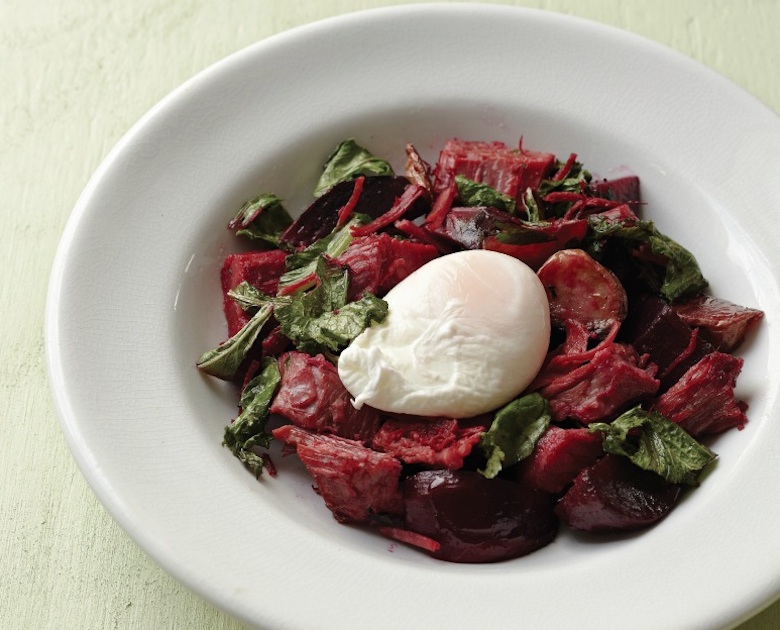
George Weld’s beautiful new book, Breakfast: Recipes to Wake Up For, celebrates iconic morning dishes of the Southern table — grits, spoon bread, country ham, corn bread, scrapple, pimento cheese, even pig-feet pancakes. But more than anything else, Weld’s book — like his just-turning-10 restaurant — is an ode to the egg.
Weld was a writer before he was a restaurateur and the stories he’s written for Edible are some of my favorites we’ve ever printed. But today I didn’t let him type, just talk. I asked about eggs — not how to eat them, but rather, what they mean to him.
Weld: One of the things about eggs as a symbol that felt right to me when I was trying to name the restaurant is that they’re ubiquitous, taken for granted and so often badly cooked. I got to a point (especially when I was vegan) that eggs just seemed gross. But eventually, as a kind of challenge to myself, I decided to try to make a perfect poached egg and all of that changed forever.
I was a grad student in creative writing at BU and I’d gotten obsessed with Wallace Stevens. I’d written papers on the tension in his work between intense intellectual drive and equally intense but often muffled sensual drive. I really identified with it. You see it in a poem like Sunday Morning, which is a kind of investigation of metaphysics but is also loaded with vivid, sensual figures — like coffee and oranges in a sunny chair.
Meanwhile, in the kitchen, I was obsessed with Marcella Hazan and her insistence on getting details right. This idea that when you do, simplicity can be transcendent, like a fresh pasta that will make you faint with joy. That’s where my head was.
I’d had one experience with a really well poached egg in Key West, where I’d gone to do research on Stevens. So making a poached egg seemed like an exciting challenge. I remember so clearly that moment in my kitchen — which was also where I wrote — breaking that egg open and being like “whoa, this is incredible.“ It was one of rare eye-opening moments. The way it bursts out of its white, and it’s so rich — something this simple, yet so beautiful, almost overwhelming sensual. Suddenly all poorly cooked eggs seemed like sins, blowing this potentially sublime experience.
Then a couple years later, working on opening my restaurant in Williamsburg, my vision was to take very simple breakfast foods — not fancy, pretentious or experimental in any way, just basic benchmarks, food my grandmother would be familiar with — and do a better job of preparing them. That translated pretty directly into egg technique. And there’s a right version, not just for poaching but for every style of egg.
For my birthday, as we were getting ready to open, my wife, Jennifer, gave me a weeklong cooking class up at CIA. It was great, but when it came time to make an omelet, it seemed insane — so French and fussy. Rolling it out like a crepe seemed ridiculous. But then I tried it and it was that poached egg moment all over again. Having tasted it, I could not go back.
This CIA version was SO much better. It was revelatory, showing you something about eggs that you wouldn’t find out any other way. So as a result, the only omelet we offer is a cheese omelet. You can get your vegetables on the side if you want but we’ve always refused to put anything else in the omelet. It’s been a subject of consternation.
Edible Brooklyn: So you named the restaurant Egg.
GW: It’s weird how often people ask about the name. People ask all the time like it’s some bizarre puzzle. It was my first restaurant, a whole new career. Plus my wife was pregnant. And the space we were in, Sparky’s, had been named after a dog, and the owners had another named Chicken.
It’s always seemed odd to me that people asked about the name. How could we have named it anything else?
Poached Eggs
It was a poached egg that brought me back into the fold of egg-eaters. I’d been burned by too many bad eggs growing up: sulfurous scrambleds, gray-rimmed hard boileds and chalky poached eggs. One day, I made a poached egg just for the challenge of it. I sprinkled some kosher salt and ground some black pepper on it, took a piece of toast out of the oven and sat down to a tiny meal that changed the way I felt about eggs. As I cut into it, I watched the yolk surge out onto the white plate, and sponged it up with a piece of bread. This was all I ever wanted in food: sensual but simple, the dumb rapture of falling in love.
People often tell you to poach your eggs in a deep pot. We don’t bother with that; we poach eggs in a shallow 1 quart pot. Some also say you need to swirl the water in your pot gently to create a vortex to drop your egg into. We don’t bother with that, either. It makes a good mess of your pot and doesn’t really improve the shape of the egg.
People are split on whether to add vinegar to the water and how much to add. We always do, partly because we like the flavor a touch of good vinegar adds, and partly because it makes the eggs easier to handle. (Eggs poached without vinegar are wildly slippery, which is fine for home, but pretty hard to handle when you’re trying to carry five plates of food out to the dining room without losing anything.)
Serves 2
2 fresh eggs, the fresher the better
2 teaspoons apple cider vinegar or any other good-tasting, light-colored vinegar such as white wine or rice wine
1 quart water
Kosher salt
Black pepper
- Crack the eggs into two individual cups. Bring 1 quart of water to a boil over high heat, then reduce to a high simmer. Add vinegar. Lower the edge of the cup to just above the surface of the water and slip the egg in.
- Let the eggs set for a few seconds before taking the edge of a slotted spoon and scraping it across the bottom of the pot to make sure the eggs didn’t stick. If they’re floating free, just let them cook gently in a simmering pot for 3 minutes.
- Remove the eggs one at a time with a slotted spoon, being careful to let all the water drain back into the pot. Check the egg for doneness: you should be able to see a well-formed orb of liquid yolk set into a gently set disk of white. (Sometimes the inner white won’t set fully and it will make the center of the egg look a little bulbous — if that’s the way your egg looks, just slide it back into the water for 20 to 30 seconds.)
- Once your eggs are done, slide them onto a plate and pull away any unsightly scraps with your fingers. If any water puddles around the egg, you can either pour it off or sop it up with a paper towel. Sprinkle with salt and pepper.
Excerpted from Breakfast: Recipes to Wake Up For © 2015 by George Weld and Evan Hanczor. Reproduced by permission of Rizzoli New York. All rights reserved.



